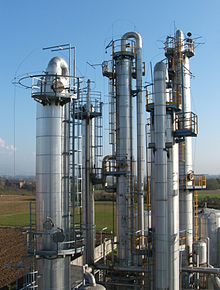Parliamentary group (chemistry)
Fraction ( Latin fractio , “fraction”) describes a subgroup of substances in a mixture of substances in chemistry, regardless of their physical state . The substances in a fraction are more similar to one another than the rest of the substance mixture. The percentage of a fraction in a mixture can be expressed as a molar fraction, as a mass fraction or, in the case of gases, more often as a volume fraction.

Examples are the CO 2 fraction in the exhaled air, the O 2 fraction of the inhaled air (FiO 2 , → ventilation ), the light oil fraction of petroleum , in biochemistry the protein fraction of milk or organelle fractions in the processing of biological tissues as well as soluble proteins on the one hand and insoluble membrane fractions on the other hand in the subfractionation of organelles (or in general membrane systems ).
separation
The extraction of plants or animal material often results in mixtures of several substances. Likewise, several substances are often created side by side in chemical synthesis. The separation of these substances is called fractionation, which results in more or less clean (uniform) fractions, with each ideally only containing one substance, which is chemically uniform. Various chemical ( e.g. precipitation ) and physical ( e.g. fractional crystallization , fractional distillation , fractional sublimation , fractional dissolution, fractional extraction , fractional sedimentation , fractional flotation and fractional electrophoresis ) methods are available to separate the fractions . When separating mixtures of substances by gas chromatography , column chromatography or thin-layer chromatography , several fractions are produced which then contain individual substances or a group of substances separately.
Analytical separation
In the analytical separation (fractionation) usually only a small amount (typically <1 mg) of the substance mixture is separated, for example by gas chromatography . The separation method is often combined with an analytical method. An example of this is the combination of gas chromatography and mass spectrometry ( GC-MS ).
The thin layer chromatography is an alternative method for the analytical separation of very small amounts of a substance mixture. In macromolecular chemistry, the separation of polymers with different degrees of polymerization into fractions of approximately uniform molecular mass plays a role.
Preparative separation
In preparative separation (fractionation), a mixture of substances in considerable quantities (typically several mg , g , kg or to ) by fractional distillation (example: separation of petroleum into petroleum fractions such as petrol , diesel fuel , heating oil , base oils for lubricants , bitumen ), fractional Crystallization (separation of solid mixtures) or separated by column chromatography (often in the organic-chemical laboratory, less often in technology).
literature
- A. D. McNaught, A. Wilkinson: amount fraction, x (y for gaseous mixtures) . In: IUPAC Compendium of Chemical Terminology (the “Gold Book”) . 2nd Edition. Blackwell Scientific Publications, Oxford 1997, ISBN 0-9678550-9-8 , doi : 10.1351 / goldbook.A00296 (English, corrected version (XML; 2006–) by M. Nic, J. Jirat, B. Kosata; with updates by A. Jenkins - Version: 2.3.3).
Individual evidence
- ↑ Otto-Albrecht Neumüller (Ed.): Römpps Chemie-Lexikon. Volume 2: Cm-G. 8th revised and expanded edition. Franckh'sche Verlagshandlung, Stuttgart 1981, ISBN 3-440-04512-9 , p. 1362.